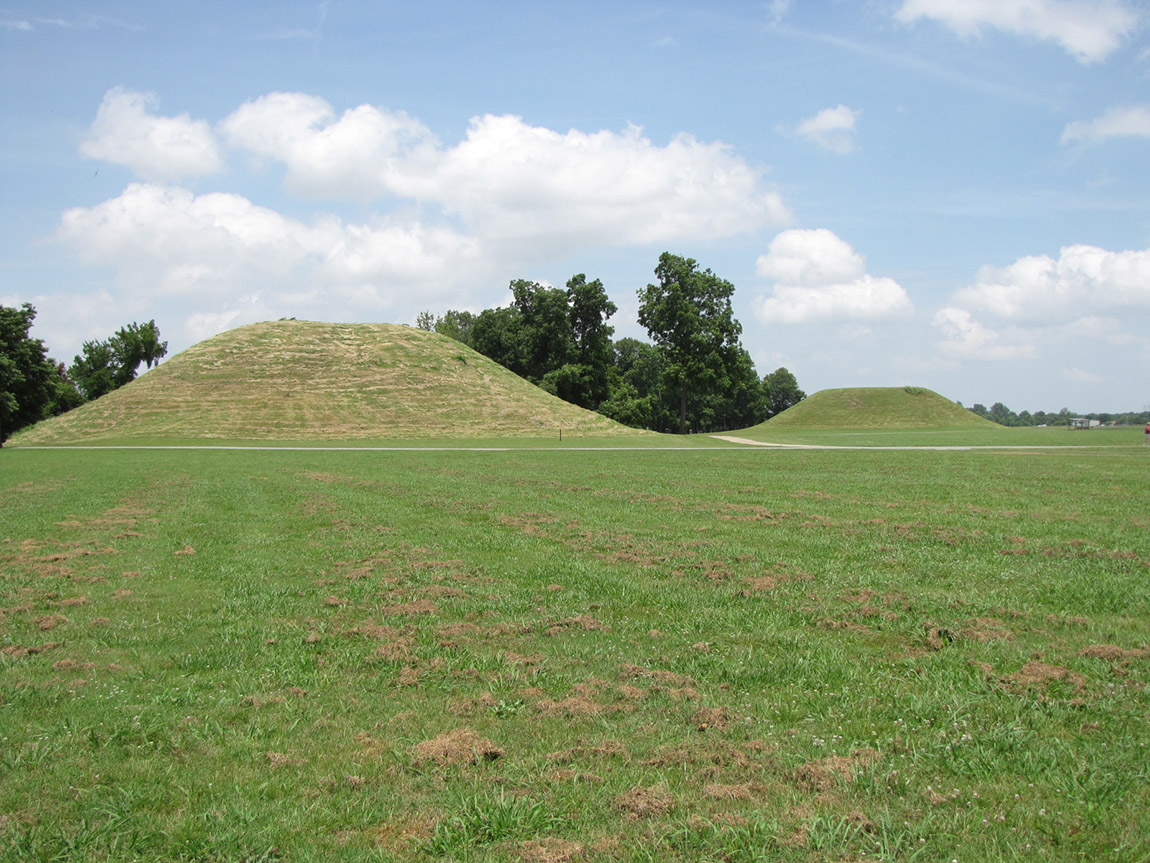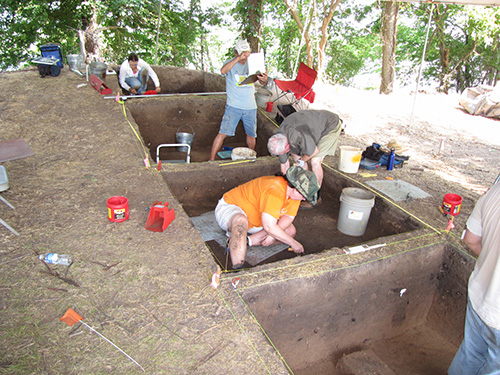
Dr. Paige Ford
ARAS Station Archeologist – Plum Bayou Research Station
November 2, 2022
After a lengthy process involving meetings and discussions with Tribal Nations, a public comment period, and successive approval by State Parks commissioners, Arkansas Department of Parks, Heritage, and Tourism (ADPHT) officially announced today that the name of Toltec Mounds Archeological State Park is now changed to Plum Bayou Mounds Archeological State Park. There is much more work to be done to solidify these changes (i.e., sign updates, exhibit development, and more), but we at the Arkansas Archeological Survey (ARAS) wanted to take the time to show our enthusiastic support for the name change, give a bit of background on the site and the original name, as well as reasonings behind the change, and consider what comes next. Future articles will delve deeper into these histories for curious minds, so be on the lookout for those.
 Toltec Mounds (hereafter Plum Bayou Mounds) is a large archeological site in Scott, Arkansas consisting of 18 earthen mounds enclosed by a ditch and an earthen embankment wall on three sides and an oxbow lake on the fourth. The earthen monuments were constructed by Native Americans during a time period spanning AD 650 to 1050 (also referred to as the Terminal Late Woodland period). This site was ceremonial in nature, where communities would hold rituals, feasts, and other religious events. While only a few religious leaders likely lived here year-round, associated peoples would travel from their hamlets and villages in the surrounding region to the site for ceremonies. Archeologists are unable to definitively associate the site with a singular Tribal Nation (though several have ancestral ties to this region such as Quapaw and Osage Nations). As such, we refer to the peoples who constructed the site and held ceremonies here as the Plum Bayou culture.
Toltec Mounds (hereafter Plum Bayou Mounds) is a large archeological site in Scott, Arkansas consisting of 18 earthen mounds enclosed by a ditch and an earthen embankment wall on three sides and an oxbow lake on the fourth. The earthen monuments were constructed by Native Americans during a time period spanning AD 650 to 1050 (also referred to as the Terminal Late Woodland period). This site was ceremonial in nature, where communities would hold rituals, feasts, and other religious events. While only a few religious leaders likely lived here year-round, associated peoples would travel from their hamlets and villages in the surrounding region to the site for ceremonies. Archeologists are unable to definitively associate the site with a singular Tribal Nation (though several have ancestral ties to this region such as Quapaw and Osage Nations). As such, we refer to the peoples who constructed the site and held ceremonies here as the Plum Bayou culture.
We have always known the name Toltec to be a misnomer – a fact that the Parks staff make well known to visitors when they arrive to learn about the site and Plum Bayou culture. Dr. Martha Rolingson—one of the founding members of ARAS and the first station archeologist at the research station housed at the state park—conducted the first modern substantive investigations at the site in 1966 in conjunction with the University of Arkansas Museum and for over 30 years thereafter. In her work, she named the people associated with the site the Plum Bayou culture. This ceremonial mound site is what archeologists call a “type site” for Plum Bayou culture, meaning it is the place where artifacts characteristic of this culture were first identified. In other words, the pottery, stone tools, and materials that are typical of Plum Bayou sites in this region were first located and defined at this site. When presented with changing the name of the park itself, it naturally follows to name the site after the culture who built it – the Plum Bayou people. Even our Native garden exhibit at the park is named the Plum Bayou Garden, attributing the Woodland varieties of plants to the very culture in this region who interacted with and used them.

Interestingly, this is not the first name change this archeological site has seen. The site was not initially referred to as Toltec Mounds, but at one time was nicknamed the Knapp Mound Group, referencing the Knapp family who owned the land throughout the latter half of the 1800s when the first archeological investigations occurred. In the 1800s, there were many theories swirling around the country regarding who built the mounds in the southeastern United States. Various folktales arose, including suggestions that giants or otherworldly beings built the earthworks. Plum Bayou Mounds was one such place, and the Knapp family supposedly believed the Toltec civilization of Mexico built the mounds on their property. According to Dr. Martha Rolingson’s entry in the Encyclopedia of Arkansas, Mary Eliza Knapp contacted the Smithsonian Institution in 1876 about the site to have these theories investigated. Smithsonian archeologists were already involved in investigations of mound sites throughout the southeastern United States, intended to scientifically evaluate who built these precontact earthen monuments. Because of her initial contact, archeologists from the Peabody Museum of Harvard University as well as with the Bureau of Ethnology (BOE) visited and investigated the site in 1879 and 1882, proving that the mounds were indeed built by the ancestors of local Native Americans and not by Toltecs. The site was investigated by Edward Palmer and is described in Cyrus Thomas’ 1894 foundational report on BOE Mound Explorations.
To complicate matters for the site (and eventual park) name, after the BOE investigations, Gilbert and Mary Knapp helped establish a township encompassing the property on which the large mound site was located. In 1888, they established a railway station at this township, which they had named Toltec. It is unclear when the site itself started to be referred to as Toltec rather than the Knapp Mound Group, or even whether the Knapp family still believed the site to have been built by Mesoamerican Toltecs after the Smithsonian investigations. But at some point after the establishment of this railway station, locals began referring to the site as Toltec Mounds. After their acquisition of the land in the 1970s, ADPHT followed suit with the naming of the state park itself, calling the park Toltec Mounds Archeological State Park since it was commonly known as such in the surrounding area. Archeologists revised their nomenclature for the archeological site itself, referring to it as Toltec in research, published reports, and more.

